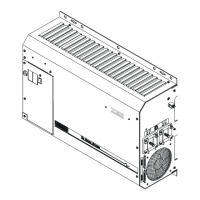MENU SYSTEM
Copyright Trace Engineering Company, Inc.
5916 - 195th Street N.E.
Arlington, WA 98223
Telephone: 360/435-8826
Fax: 360/435-2229
www.traceengineering.com
PS Series Inverter/Charger
Part No. 3597
Rev. D: November 23, 1999
Page
45
MENU HEADING - INVERTER SETUP (9)
Set Grid Usage
FLT SELL SLT LBX
• FLT - Float will try to maintain the batteries at the float voltage level. This can be used when the
source of power is a utility grid or a generator. When AC power is available, the inverter will complete
a full three stage charge cycle and then hold the battery at the float level until the source of AC power
is no longer available. This is the default setting and is appropriate for use with stand-alone systems
with back-up generators or utility back-up systems. FLT mode does not sell excess power into the
utility grid. If a DC power source is available and the battery is full, its power will be used to directly
power the AC loads connected to the inverter output even though the utility grid is also connected to
the loads. If more power is available from the DC source than is required to power the AC loads, the
battery voltage will increase above the float level. An external charge control device is therefore
required to prevent over charging of the battery.
• SELL – SELL mode enables the inverter to “sell” the excess power to the grid (the ‘MAXIMUM
AC AMPS IN’ switch must be in the AC1 position). This mode must have the approval of the
local power utility prior to its use. In the US, utility companies are required by law to purchase any
excess power generated by their customers; however, they decide what can be connected and what
safety requirements must be met. Be advised: some utilities will be more receptive than others will.
The most advantageous configuration is called “NET” metering where only one meter is installed and
spins either direction. The purchase and sell prices are equal. “Dual” metering requires two meters
and is less desirable since the power you sell is worth only a fraction of the price for the power you
purchase. Power from any DC source, such as a solar array, and the battery can be sold. When
power from a DC source is available, it will be used to power any AC loads connected to the AC
output first. Any excess power available from the system will be sold “into” the utility grid through the
AC input terminals with the ‘MAXIMUM AC AMPS IN’ switch in the AC1 position.
• SLT - The silent mode does not maintain the battery at float voltage all the time (the
‘MAXIMUM AC AMPS IN’ switch must be in the AC1 position). The battery charger only operates
for part of each day. AC power from the utility grid is passed through the inverter to the loads 24
hours a day. Once a day, at the time prescribed by the BULK CHARGE TRIGGER TIMER, the
batteries are given a bulk and absorption charge cycle. The inverter will perform a bulk charge once
per day from the grid, charging the battery near the BULK VOLTS DC setting until the battery charger
has held the battery near the BULK VOLTS DC setting for the ABSORPTION TIME period setting.
The inverter will then go totally silent and will wait for the utility power to fail, or until the next day
when it performs another bulk charge. After each power outage, the inverter will perform another bulk
charge cycle once the AC source has returned. This is typically used only in utility back-up
applications.
• LBX - The low battery transfer mode allows a system to automatically switch between utility
connected and stand alone battery operation (the ‘MAXIMUM AC AMPS IN’ switch must be in
the AC1 position). In this mode, the inverter will power the loads from the battery and solar array (or
other energy source) until the battery voltage drops to the LOW BATTERY TRANSFER VDC setting.
It will then connect to the utility grid and the loads will be powered by the utility until the battery
voltage - charged by the alternative power source (solar, wind etc.) - reaches the LOW BATTERY
CUT IN VDC setting. The inverter will then disconnect the utility and power the loads from the battery
and any other source of DC power connected. This mode is often used instead of the SELL mode
because approval from the utility is not required - no power will be sent into the utility distribution
system when LBX is selected. To use the LBX mode, the AC source (Grid) must be connected to AC
input and the ‘MAXIMUM AC AMPS IN’ switch is must be the AC1 position. Transfer to the inverter
will not occur if the ‘MAXIMUM AC AMPS IN’ switch is in the AC2 position. Caution: If the system is
not properly sized, the LBX mode can result in frequent transfers from the battery to the utility and
result in poor performance of the system and excessive energy consumption from the utility. The daily
output of the alternative power source (solar, wind etc.) should be able to meet the daily power
requirements of the loads being operated under typical conditions. See the Low Battery Transfer
mode section for more information.

